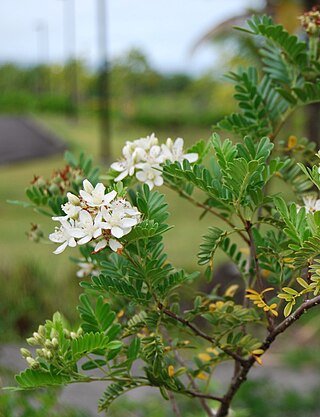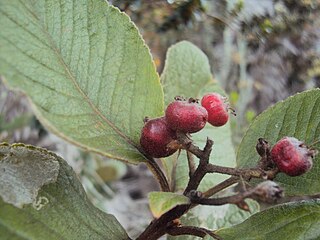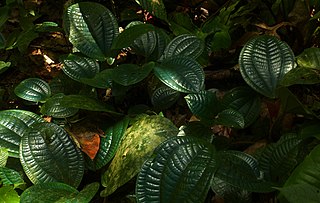
Alders are trees that compose the genus Alnus in the birch family Betulaceae. The genus includes about 35 species of monoecious trees and shrubs, a few reaching a large size, distributed throughout the north temperate zone with a few species extending into Central America, as well as the northern and southern Andes.

The MaloideaeC.Weber was the apple subfamily, a grouping used by some taxonomists within the rose family, Rosaceae. Recent molecular phylogenetic evidence has shown that the traditional Spiraeoideae and Amygdaloideae form part of the same clade as the traditional Maloideae, and the correct name for this group is Amygdaloideae. Earlier circumscriptions of Maloideae are more-or-less equivalent to subtribe Malinae or to tribe Maleae. The group includes a number of plants bearing commercially important fruits, such as apples and pears, while others are cultivated as ornamentals.

Amygdaloideae is a subfamily within the flowering plant family Rosaceae. It was formerly considered by some authors to be separate from Rosaceae, and the family names Prunaceae and Amygdalaceae have been used. Reanalysis from 2007 has shown that the previous definition of subfamily Spiraeoideae was paraphyletic. To solve this problem, a larger subfamily was defined that includes the former Amygdaloideae, Spiraeoideae, and Maloideae. This subfamily, however, is to be called Amygdaloideae rather than Spiraeoideae under the International Code of Nomenclature for algae, fungi, and plants as updated in 2011.

Caperonia is a genus of plants of the family Euphorbiaceae first described as a genus in 1825. The genus is native to tropical and subtropical America and Africa.

Obovaria is a genus of freshwater mussels, aquatic bivalve mollusks in the family Unionidae, the river mussels. There are at least six described species in Obovaria at present, all of which are found in the United States. Obovaria subrotunda is found in Canada as well.

Obovaria subrotunda, commonly called the round hickorynut, is a species of freshwater mussel, an aquatic bivalve mollusk in the family Unionidae, the river mussels.
Dracaena konaensis, synonym Pleomele hawaiiensis, the Hawaiʻi hala pepe, is a rare species of flowering plant that is endemic to the island of Hawaiʻi in the state of Hawaii.

Osteomeles is a genus of plants in the rose family, Rosaceae. They are shrubs native to eastern Asia, with compound leaves, opposite leaf arrangement, and small pome fruit. The fruits of all species in this genus are edible.

Osteomeles anthyllidifolia, commonly called ʻŪlei, eluehe, uʻulei, Hawaiian rose, or Hawaiian hawthorn, is a species of flowering shrub in the rose family, Rosaceae, that is indigenous to Hawaiʻi, the Cook Islands, Tonga, Pitcairn Island, and Rapa Iti, Taiwan and the Ryukyu Islands of Japan.

Osteomeles schwerinae is a species of plant native to China. Its flowers are white and resemble those of hawthorn species. It produces small, white, round berries that are pomes. The fruits are edible and can be eaten raw or used to make jellies and jams. The fruits have a sweet flavor. It is grown in gardens as an ornamental plant. It is also used in bonsai. O. schwerinae can be found in mainland China and Taiwan.

Jaguar Land Rover Automotive PLC is the holding company of Jaguar Land Rover, also known as JLR, and is a British multinational automobile manufacturer which produces luxury vehicles and SUV and has its head office in Whitley, Coventry, United Kingdom. The principal activity of Jaguar Land Rover is the design, development, manufacture and sale of vehicles bearing the Jaguar and Land Rover marques.
Flora of China is a scientific publication aimed at describing the plants native to China.

Kadua coriacea is a rare species of flowering plant in the coffee family known by the common name kioʻele. It is endemic to Hawaii, where it is known only from the island of Hawaiʻi and one individual remaining on Maui. It is a federally listed endangered species of the United States.

The Maleae are the apple tribe in the rose family, Rosaceae. The group includes a number of plants bearing commercially important fruits, such as apples and pears, while others are cultivated as ornamentals. Older taxonomies separated some of this group as tribe Crataegeae, as the Cydonia group, or some genera were placed in family Quillajaceae.

Malinae is the name for the apple subtribe in the rose family, Rosaceae. This name is required by the International Code of Nomenclature for algae, fungi, and plants, which came into force in 2011 for any group at the subtribe rank that includes the genus Malus but not either of the genera Rosa or Amygdalus. The group includes a number of plants bearing commercially important fruits, such as apples and pears, while others are cultivated as ornamentals.

Hesperomeles is a genus of South American evergreen trees of the family Rosaceae that has sometimes been included along with Pyracantha in the genus Osteomeles. However, Osteomeles notably have compound leaves, and recent molecular phylogenetics suggests that Hesperomeles is only distantly related to Osteomeles, and is instead sister to the Crataegus—Mespilus clade.

Nezara is a genus of plant-feeding stink bug of the family Pentatomidae, first described by Charles Jean-Baptiste Amyot & Jean Guillaume Audinet-Serville in 1843.
Epichostis subrotunda is a moth in the family Xyloryctidae. It was described by Yuan and Wang in 2009. It is found in China.

Phyllagathis is a genus of flowering plants in the family Melastomataceae, native to India, southern China, Southeast Asia, and Malesia. The taxon is believed to be highly polyphyletic.

Diplodonta is a genus of bivalves belonging to the family Ungulinidae.















